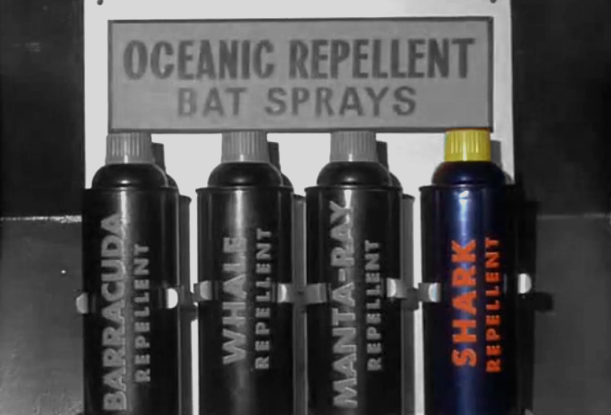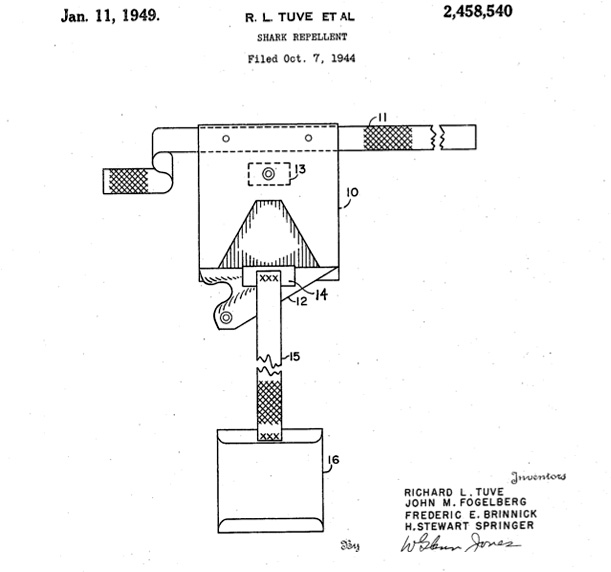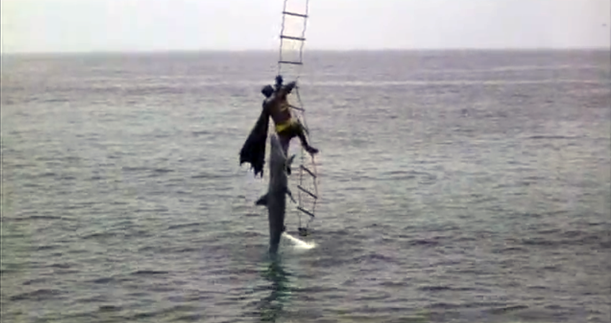Shark Repellent: It’s Not Just For Batman Anymore
It was actually first developed during World War II in an effort to help save the lives of seamen and pilots who had to await rescue in open water
Holy sardines! It’s a still from the 1966 film Batman
Every superhero would be wise to heed the lessons of the Caped Crusader, as explored below in the first of our series on shark-related patents and designs.
Today we look at shark repellent, the most famous of which was seen in the exciting opening of the original Batman film –that’s with Adam West not Michael Keaton– when the Caped Crusader is attacked by a shark while trying to intercept a boat with a helicopter – I’m sorry, Batcopter. Pretty typical Batman stuff, really. His first solution? Punch the shark – sorry, Batpunch the shark. The shark doesn’t give up as easily as the average cartoonish henchman, so Batman tries plan B: Bat shark repellent. It works. The shark falls into the ocean and EXPLODES. I honestly didn’t see that coming.
Well, it turns out that shark repellent is real, although I’m not sure it has been bat-weaponized into a convenient aerosol bomb. So unfortunately, it looks less like this:

Thankfully, Batman clearly labels all his Bat Sprays so this image is pretty straightforward. A still from the 1966 film Batman
And more like this:

U.S. patent no. 2,458,540 for “a composition and device for discouraging the predatory intentions of carnivorous fish” aka SHARK REPELLENT (image: google patents)
It probably won’t surprise you to hear that it’s not quite as effective as the explosive bat spray. (Correction: The Joker had rigged the shark to explode, as villains are wont to do.)
Real shark repellent was first developed during World War II in an effort to help save the lives of seamen and pilots who had to await rescue in open water. The patent for “shark repellent” was issued to a team of American chemists –Richard L. Tuve, John M. Fogelberg, Frederic E. Brinnick, and Horace Stewart Spring– in 1949. Typically, these patent applications are pretty dry, but this one introduces the invention with a surprisingly vivid description of the problem faced by soldiers during the war:
“Since the beginning of the war with its submarine and air activity, numerous occasions have arisen in which men have been forced to swim for their lives. Our armed services and merchant marine have been helpful by providing the men with equipment to help them stay afloat. This phase of the problem or, rather, the equipment long ago reached a point of development where remaining afloat for extended periods offered little difficulty. In cold Atlantic waters, the greatest menace has been the cold. However, in the warm Pacific Ocean and the South Atlantic, a different menace arises for the waters are alive with carnivorous fish. The weakened condition of wounded men cast into the water puts them at a distinct disadvantage in trying to fight off sharks and barracuda which are attracted by their blood.”
Their design is a small chemical disk in a waterproof package that can be attached to a life vest. In the event that someone is stranded at sea, the disk can be exposed to seawater, which will activate the chemicals to “cast a protective veil of a chemical material around the swimmer.” Those chemicals consist primarily of copper acetate. which is safe for the swimmer but has been proven to be so distasteful to sharks that they’ll ignore raw meet meat floating in a pool of the mixture. It approximates the odor of dead shark – the only thing that’s been proven to repel the carnivorous fish.
The inventors had the good of all humanity in mind and specified that the deterrent could be used by any world government without the payment of royalties. While no shark repellent is fool proof, early tests of the 1949 repellent showed that the copper mixture was 72-96 percent effective. Later tests showed that maybe it wasn’t so effective. Work continued.
More recently, researchers have been working on a more effective shark repellent that is literally derived from a distilled essence of dead shark and has proven effective on a number of species. In 2001 chemical engineer Eric Stroud started the company Shark Defense to refine an array of chemical and electrochemical shark deterrents such as shark resistant sunscreen and fishing hooks, and hope to someday offer shark repellent fishing nets and other products to protect boats and submarines.
Although advancements have been made, the perfect shark repellent continues to elude scientists. So if you’re planning to watch all of Shark Week in situ, I’d recommend getting to work on a weaponized Bat Spray.
/https://tf-cmsv2-smithsonianmag-media.s3.amazonaws.com/accounts/headshot/Jimmy-Stamp-240.jpg)

/https://tf-cmsv2-smithsonianmag-media.s3.amazonaws.com/accounts/headshot/Jimmy-Stamp-240.jpg)